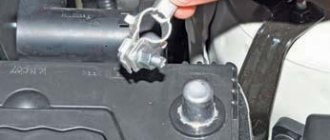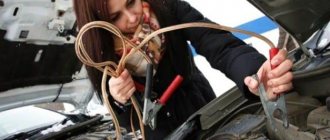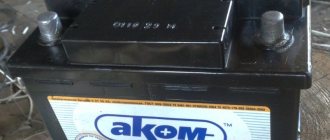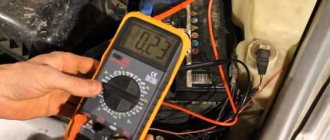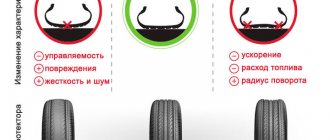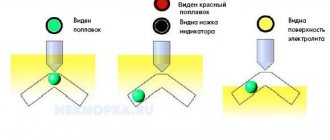What is inrush current and what does it depend on?
The starting current is also called the cold cranking current, which indicates the main value of this parameter for the machine. When the engine is not warmed up, the oil in it is in a more viscous state, so at the moment of starting, the starter consumes a large amount of electricity.
Considering the extremely low resistance of the electric motor winding, in order to perform the work of rotating the rotor, it will be necessary to supply high-power electricity from the battery, and the higher the cold cranking current, the easier it will be to start the car.
The power of the electric current is calculated using the formula: P=UI.
In this expression, P is power; U – voltage; I – current strength. The voltage of a healthy battery is approximately 12 Volts, therefore, the higher the current value, the higher the power the starter motor can develop. You should also take into account the fact that at the moment the electric engine starts, this parameter is always higher than when its speed increases significantly, so the car starter battery must have a significant reserve for this indicator.
Technical requirements and standards of different countries
All over the world, there are several standards for determining the value of an engine cold start, which differ in their numerical expression. Often, several options are indicated on battery labels:
- most often this is the German system - DIN;
- American – SAE;
- European Union - EN 60095.
On most Russian car batteries, the cold start current is indicated in DIN and EN standards.
Specific values are obtained from the following tests:
- SAE (JS537)/CCA. According to the American standard, the battery is cooled to a temperature of -18 degrees during the day, after which it is loaded with a current equal to the rated CCA value. If the voltage does not drop below 7.2 Volts within 30 seconds, the test is passed.
- EN (EN50342.1A1). This technique differs in that the voltage should not drop below 7.2 Volts in 10 seconds.
- DIN. According to this standard, the voltage should not fall below 9 Volts for 30 seconds, 6 Volts for 150 seconds.
The same indicators according to these standards have different digital designations.
| DIN (Amperes) | EN (Amperes) | SAE (JS537) (Amps) |
| 170 | 280 | 300 |
| 220 | 330 | 350 |
| 255 | 360 | 400 |
| 280 | 420 | 450 |
| 310 | 480 | 500 |
| 335 | 520 | 550 |
| 365 | 540 | 600 |
When purchasing a rechargeable starter battery, you can focus on the technical requirements of a particular vehicle.
What does the starting current of a battery affect?
As proven above, this parameter affects the power of the electric starter motor. Increasing power allows the rotor to rotate at higher speeds, so the engine crankshaft, when the engine starts, also rotates much faster. The faster the pistons rotate, the more compression strokes occur per unit time, so the diesel engine starts much faster. In a gasoline engine, an increase in crankshaft speed also leads to a decrease in starting time.
If the battery has the necessary starting current characteristics, then even in severe frosts the car can be started without resorting to additional measures to warm up the engine. If the engine does not start as quickly as in the summer, then a more powerful battery will allow the pistons to rotate for a longer time without a significant reduction in speed, which will lead to heating of the rubbing parts and easier ignition of the combustible mixture.
What should be the starting current to start the engine?
The starting current for starting an engine of a certain brand must be calculated at the power unit manufacturer. The indicators of this parameter increase with increasing its capacity, so if you know what kind of battery was in the car, you can easily select a new battery based on capacity. In this case, the electrical parameters will fully correspond to the make and type of car.
If it is necessary to install a battery on a vehicle that did not have a battery, then products with the following minimum cold cranking current values are selected:
- For passenger cars - 350 A.
- For trucks - 800 A.
What should the cold cranking current be?
The inrush current is sometimes also called the cold cranking current. But some car enthusiasts ask the question: “What should it be like?” When purchasing a storage battery, this parameter plays an important role. Although everything is actually very simple. For example, to start an engine, you need 500A. Therefore, we choose a battery with 100A more.
If you use a device with exactly the same performance or less current, then the device will very quickly fail.
ATTENTION! When choosing a battery, you should remember that when starting the engine, the starter will continue for another 30 - 40 seconds. spin. If you start the car for longer, then there is a chance that the battery will simply overheat. You also need to pay attention to what type of car (passenger car, gazelle, KAMAZ, long vehicle, etc.).
Another important role is played by the type of engine. Diesel engines have preheaters. Therefore, the cold cranking current must be at least 350A.
Gasoline engines do not require high cold cranking current. 100A is enough for them. And for cold regions it is tedious to take devices with at least 225A.
Table of optimal indicators
Starting current and capacity of different batteries.
| Battery name (standard is indicated in brackets) | Starting current (A) | Capacity (Ah) |
| Varta 6ST-60 BLUE dynamic (D47) (DIN) | 540 | 60 |
| Forse 6ST-60 Az (En) | 600 | 60 |
| BOSCH 6CT-60 S4 SILVER (S40 060) (EN/DIN) | 540 / 324 | 60 |
| Varta 6ST-60 Silver Dynamic AGM (D52) (EN) | 680 | 60 |
| Bosch 6CT-95 S6 AGM HighTec (S60 130) (EN) | 850 | 95 |
| AGM Exide ES2400 (EN) | 210 | 630 |
| Cartechnic 6St-225 AzE CART725012115 | 1150 | 225 |
Cold cranking current is a very important indicator, especially for the weather conditions of our country. In the southern regions the battery feels quite comfortable. Therefore, they don’t even look at the starting current parameters.
The northern regions are another matter. Residents of these regions should pay attention to this indicator. Because cold conditions turn the oil into a thick paste, making it difficult to start the engine.
Important! In cities that are located closer to the North Pole (Surgut, Murmansk, Yamal, etc.) during very cold times, drivers do not turn off their engines at all. After all, if you leave your car with the engine turned off overnight, it will simply be impossible to start it in the morning.
Engines in warm regions at temperatures from +1 to +5 o C start quietly at 200 - 220 Am. But when the temperature drops to -10 or -15 o C, 30% more power is required. Those. You need to choose a 260 or 270 Am battery. And when it drops to -30 or -40 o C, the strength of the electric current increases even more.
How can you check the starting current of a battery?
Only comparative tests of batteries based on cold cranking current can be done by ear. If the engine rotates at a higher frequency when starting and the car starts up faster, then for this battery model this indicator is noticeably higher.
You can accurately measure the starting current using a special device. As a rule, to check the performance of the battery during sale, diagnostics are performed using a load fork. Such a device consists of a low resistance load and a built-in measuring device that displays the voltage. In this way, it is possible to assess the general condition of the battery, but it is almost impossible to accurately determine the magnitude of the discharge current.
The value of the cold cranking current of a battery can be determined with high accuracy only by a professional tester. Such devices cost several tens of thousands of rubles, so this method is completely unsuitable for one-time use.
Is it possible to use a battery with a high starting current?
Contrary to popular belief that installing a more powerful battery will lead to failure of car electronics, including the starter, we should recall the school physics course, which explains the basic patterns of electricity consumption. Regardless of the power of the battery, the devices will consume only the required amount of electricity, and the starter can fail only if the limit for a single start of this element of the vehicle’s electrical system is significantly exceeded.
Difficulties with installing a more powerful battery can arise only due to insufficient space in the engine compartment. The greater the power of the battery, the larger its dimensions. The length of the product increases especially significantly with increasing capacity and power, so it is possible to install a product in its standard location that significantly exceeds the standard battery in power for a given model of car only after making changes to the design of the battery installation location.
Which batteries have a high starting current? Table of battery currents of different manufacturing technologies.
The starting current, measured in amps, often has a direct relationship with the battery capacity, measured in amp-hours. The larger the battery capacity, the more current it will produce. But there are 2 pitfalls here; this rule only applies if two conditions are met:
- The size and manufacturing technology of the electrodes are the same.
If one battery is made of plates made by gravity casting, and the other by stamping, then the starting current of a battery with a capacity of 55 A/h by stamping will exceed the current of a 60 A/h battery made using plates obtained by casting. The difference lies in the thickness of the plates. To get 60 capacity from calcium batteries, a larger number of plates is required, because they are thinner. In this case, the “current collection” area is larger due to the larger number of plates. This is why calcium batteries produce significantly more current than their capacity brothers made using less modern technologies.
- The dimensions of the plates are the same.
As we wrote above, the larger the area of the plates, the greater the inrush current. This means that the starting current of a 75 A/h battery can be greater than that of a 90 A/h battery, since the dimensions of the electrodes differ significantly.
The influence of battery manufacturing technology on the starting current:
Is it possible to use a battery with a lower starting current?
Despite the fact that a battery with a lower starting current can almost always be installed in a regular place, it is not worth purchasing such a battery. If the battery delivers less power than is necessary for normal operation of the starter, then the rotation of the electric motor rotor will occur with significantly less frequency.
Accordingly, the crankshaft will also not rotate fast enough, which may cause the internal combustion engine to fail to start. If this indicator is at a very low value, then the rotation of the electric motor may practically stop, which will lead to damage to the brushes and starter commutator.
Classification accepted in the world
In world practice, you can find different classifications by which the starting current of a particular battery is determined. For convenience, a marking system has been developed: when you find certain letters, you will immediately understand where the battery was manufactured. The main classifications of PT include:
- In Germany - DIN
- In the USA - SAE
- In the countries of the European Union (except Germany) - EN
- In Russia, Ukraine and some countries of the former USSR, the inscriptions “starting current” and also “starting current” are common.
If, when purchasing a new battery, these indicators are not on the case (which is extremely rare), the starting current figures should be in the instructions/booklet.
How to select starting current based on vehicle parameters
The starting current of the battery is selected based on the following parameters:
- Engine's type.
- Availability of additional electrical equipment.
- Operating conditions.
The more powerful the engine and the greater the number of pistons the power unit has, the greater the current required to start it. Powerful audio amplifiers, climate control equipment and additional lighting will also require more electricity.
If the car is operated in harsh climatic conditions, for example, in the Arctic, then a more powerful battery should be installed on the car, which will allow the engine to start even at very low air temperatures.
Tips for choosing a battery
Winter, the first frosts, the car alarm not working, the car not starting with the key, flooded candles and in the evening, after work, being towed to the car wash... Is this a familiar story? If not, then you are lucky and have not yet encountered all the delights of a suddenly dead battery.
This article will talk about an integral part of any vehicle - a car battery. To choose the right battery for your car, you need to have an understanding of some basic concepts.
Battery capacity is the ability to produce a certain current over a certain period of time.
The inrush current is the maximum current that a fully charged battery can produce for a short time. And it is this parameter that primarily affects whether the engine starts successfully or not. Many car owners confuse these 2 concepts and believe that the larger the battery they install, the easier it will be for them to start in winter. Indirectly, they are right, they will start easily until the battery capacity drops to a critical value. But, no matter how powerful the battery is, if the current consumption exceeds the charge, at some point the battery will give up and will no longer be able to start the car. From the factory, the car is equipped with a battery that is approximately equal to the performance of the generator. This is done on the basis that the battery is fully charged in 10-12 hours.
If we take a battery with a smaller capacity, it will be charged with a current higher than permissible. In a charged state, it will “boil” excessively, as a result of which it will fail faster. Well, and, accordingly, at low sub-zero temperatures it simply may not be enough to start the car. If we take a battery with a larger capacity, nothing bad will happen, and for cold climates it is even recommended to do so. But one important point must be taken into account. If a factory-capacity battery charges in 10-12 hours, then a larger battery will take longer to charge. Accordingly, before winter, such a battery must be fully charged, preferably on an external charger, so that initially we already have a larger safety margin.
Explanation of the battery designation
We have sorted out the choice of battery parameters, now a few words about decoding the name of the battery. It usually consists of a group of numbers and letters, for example 55B24L:
55 – Indicator indicating battery capacity. We can consider it virtual, because... The parameters of batteries made in Europe and Japan are measured using different methods. And, first of all, when determining the battery capacity, you need to look for the value in A/h (Ampere/hour). For batteries made in Japan, this index will correspond to a capacity of 36Ah, for a European one - 45Ah.
B – battery class. This actually means the width of the battery. Typically, it is 120mm, and such a battery is popularly called “narrow”. It is the most common, found mainly on cars with engines up to 1.8 liters.
And also under this index lies another important parameter - the size of the terminals. Batteries with index B have thin terminals and are available with a maximum capacity of 60Ah. Everything higher has a D index, and they already have thick terminals.
24 – battery length in centimeters. May have slight deviations within ± 3mm.
L – battery polarity, or, more simply, the location of the terminals. This polarity is called reverse. To check this, place the battery with the long side facing you, so that the terminals are closer to the opposite long side. If + is on the right and minus is on the left, the polarity is reversed. If it’s the other way around, it’s straight R. Reverse polarity batteries are installed on most European and Japanese cars. On domestic cars, the battery polarity is straight.
Types of batteries
If several decades ago battery manufacturing technologies were such that it was constantly necessary to monitor the level of electrolyte and its density, because it was constantly boiling away, now this is all in the past. Today, 80% of all batteries produced are maintenance-free. This means that you don’t need to measure or add anything to them. All that is required for the health of such a battery is to keep it constantly charged and at a temperature as close to optimal as possible. And also choose the right one for your car.
In the production of modern batteries, various technologies are used, the main task of which is to make the car battery as unpretentious as possible, not requiring third-party intervention. So which battery should you choose? The most common today:
Low antimony:
Budget class serviced batteries. They replaced the classic antimony batteries. The name comes from the name of the additive - antimony, which is added to the composition of lead plates. Compared to their predecessors, they have less evaporation of water from the battery, and therefore need to be serviced less frequently.
Advantages
This type of battery is low in price. After a short deep discharge, in most cases the battery can be restored.
Disadvantage
is the fastest self-discharge.
Hybrid:
They have electrode plates made of different materials. Usually the positive plate in them is low-antimony, and the negative plate is lead-calcium ( marked
Ca on the battery
), or with the addition of silver (
Ag) .
This is the most common type of battery.
Dignity
This type is characterized by low cost, the ability to withstand deep discharges, and they also have much lower self-discharge and ability to boil away compared to the previous class.
Calcium (Ca-Ca):
The plates of both the negative and positive poles in this battery are calcium.
advantages follow from this:
:
— Their susceptibility to self-discharge is 70% lower than that of low-antimony ones, boiling is minimal.
— Batteries of this type are always maintenance-free and do not require topping up.
— Good performance at low temperatures
— They have high inrush currents, high capacity, long service life, and are not afraid of overcharging
minuses:
— During deep discharge, the positive electrode is coated with calcium sulfate, and, unlike lead sulfation, this process is irreversible. After this, the battery most often has to be replaced.
About the effect of cold on battery capacity
Here lies one very important point that must be taken into account when choosing a battery for harsh operating conditions. When calculating the starting current of the battery, the current consumption of the starter is taken, because It is he who is the main consumer when starting the engine. This current ranges from 100-300A/h for engines of different sizes. All modern batteries have a starting current of 430A/h. It seems that everything is fine, we are able to cope with a reserve even with the most powerful starter. But what's the catch? After all, 5L engines don’t have a 45Ah battery? But the point is this: the lower the temperature of the battery, the slower the chemical processes occur in it, and the more its capacity shrinks. So at -30C the battery capacity decreases by about 60%! Those. if our battery was capable of delivering 500A of starting current, then in such cold weather only 200 is left, which is much closer to real consumption. And this is with a fully functional and charged battery, otherwise the picture will be even sadder.
Therefore, we use a simple folk rule: if winter temperatures often stay around -30, the battery should be taken 10-20Ah more than the factory value.
Using a car blanket is also very useful in winter. It will make the battery feel better and save fuel for car starts, since the car will cool down more slowly and, accordingly, start up less often.
Our online store has a large selection of car batteries at an affordable price! It’s very easy to buy car batteries in Krasnoyarsk with home delivery!

